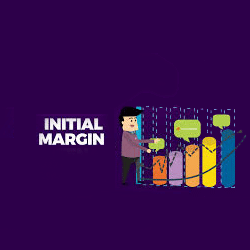
For the purchase of securities, investors borrow cash from brokerage firms via margin accounts. A specific rate of interest is charged by the broker for the borrowed amount. To become eligible for the margin account, the investor should provide specific funds in the form of collateral, money, or securities. This requirement is called the initial margin.
How the Requirement Works
Setting up a margin account gives investors and traders the capability of buying securities of a value much higher than the balance they have in the account. In other words, the account is a debit account, which incurs interest on the due margin balance.
The Federal Reserve Board has fixed the prevailing initial margin value at 50%, according to its Regulation T. But, this is just the minimum required regulation. Equity firms and exchanges are allowed to fix the amount more than the percentage fixed by the Federal Reserve.
The initial margin is not to be confused with the maintenance margin as the latter is the equity percentage an investor has to maintain.
Variation margin is another collateral type like IM, which is paid on daily basis in a trade. This is reflective of the trade’s existing value. Initial margin is utilized to balance the losses accrued in the span between a defaulter’s previous payment of variation margin and the hedging or replacing point.
For cleared trades, the span ranges from five days up to seven days. Thus, the initial margin is a significant factor when huge portfolios are involved. IM is started during the execution of a trade and later adjustments are made all through the trade.
Example
An investor looking to gain a buying power of $200,000 should provide a contribution of $100,000 as of the margin account for the IM percentage of 50%. The broker would lend $100,000 to the investor.
Uses of Initial Margin
With the IM percentage, it is possible to find the purchasing power multiplier. The margin amount a brokerage can offer its customers is based on the risk limits of the firm and the client.
Usually, the cash offered is twice that of what is held in an account but many forex brokerages provide a purchasing power of 50:1. The purchasing power multiplier is found using the formula below:
Purchasing power multiplier = 1 / initial margin
For an IM of 40%, the purchasing power multiplier will be 2.5 x 1/40%. For an investor contribution of $100,000, the buying power will be 2.5 times the value, which is $250,000 from which $100,000 is deducted making the borrowed funds $150,000.
Different Structures of IM
IM plays a significant role in derivatives markets as it covers several aspects of transactions, including credit, financing, marketing, legal, and operations.
The IM is formulated in various ways based on transaction types and debt forms used.
The various IM forms are:
- Fixed dollar
- Fixed percentage
- Fixed shares
- Fixed declining dollars
There are other variables-based IM calculations such as assessing the remaining years of a transaction and considering amounts, which fall into effect due to capital change, a downgrading of ratings, or defaults of covenants.
IM can also be in the form of value that grows or reduces on a specific valuation based on the direction and value of the replacement price of a transaction portfolio between the concerned parties. This includes the amount after netting, which is termed as initial margin rebate.
Final Takeaway
Initial margin is used as a hedging tool to counter the losses that a variation margin cannot cover due to the credit situation or the market conditions. Firms that use the initial margin make wise credit choices and avoid losses. If the IM is done without errors in the determination, communication, processing, and monitoring, it can be risk-free.








Leave a Reply